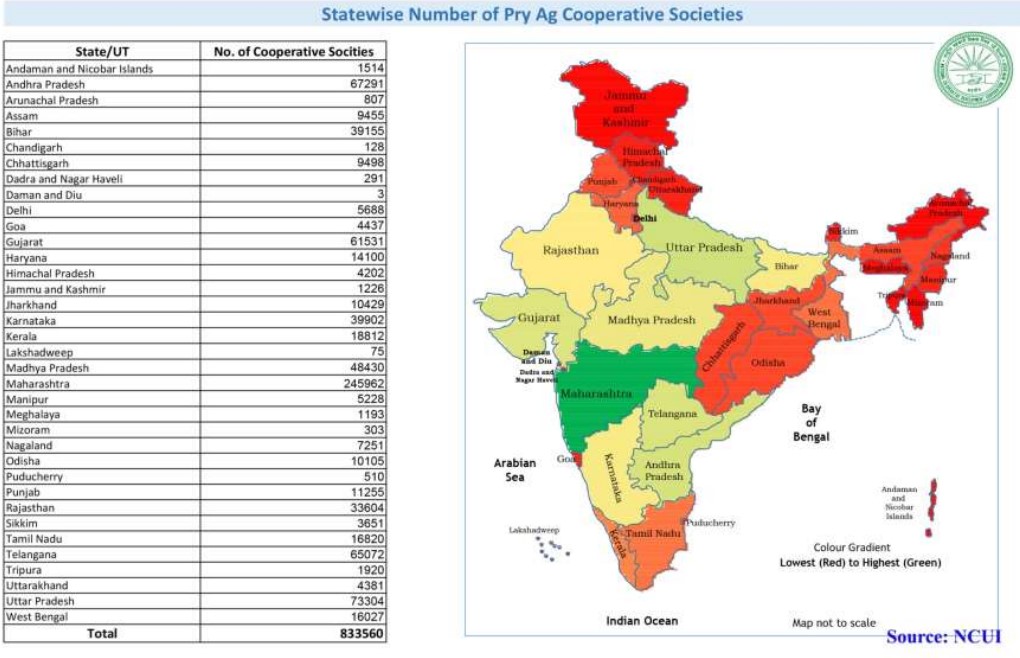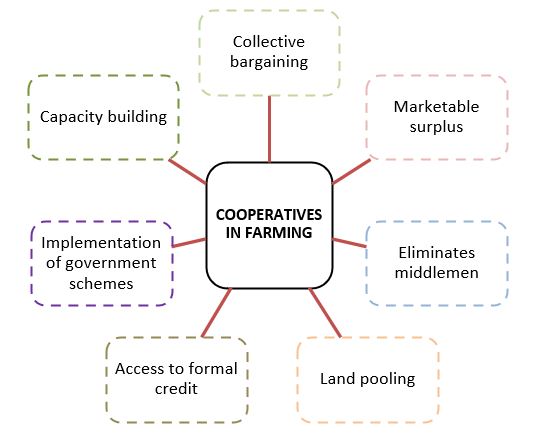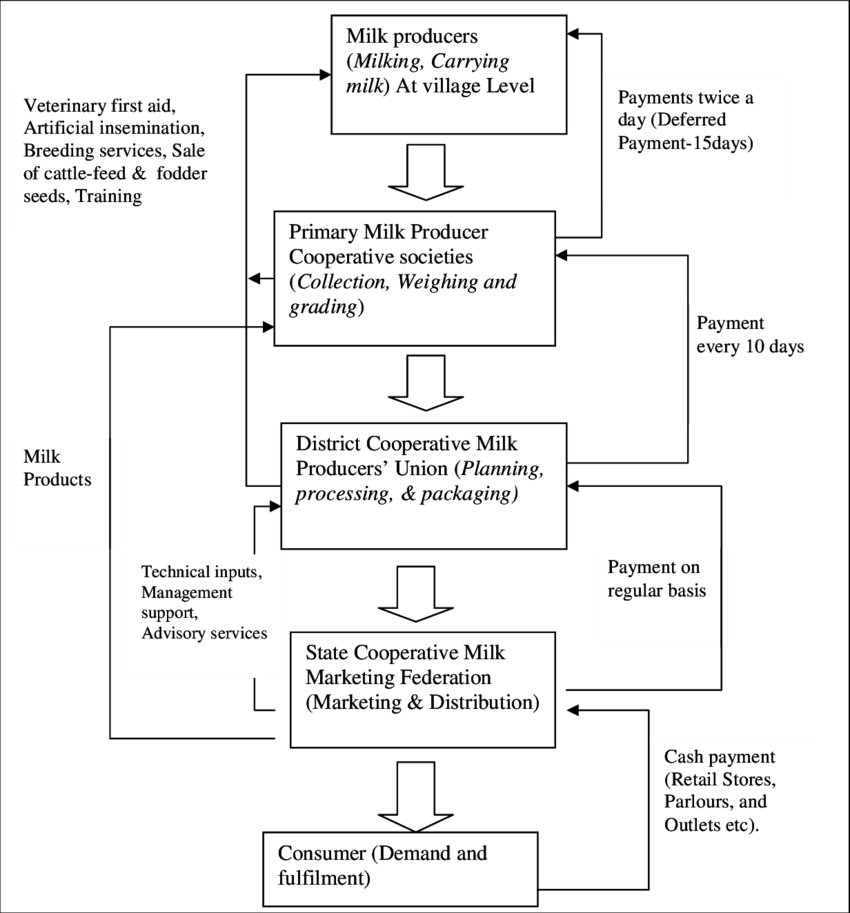Cooperatives in agriculture
2023 JUN 6
Mains >
Social justice > Development Processes & Industry > Cooperatives
IN NEWS:
- The Union cabinet cleared a Rs. 1 trillion scheme to increase foodgrain storage capacity by 70 million tonnes in the cooperative sector. This will be world’s largest grain storage plan in the cooperative sector.
COOPERATIVES:
- A cooperative is an autonomous association of persons united voluntarily to meet their common economic, social and cultural needs and aspirations through a jointly-owned and democratically-controlled enterprise.
- Its aim is to serve the interest of the members, usually from poorer sections of society, through the principle of self-help and mutual help.
- In India, a cooperative society can be formed under provisions of the Co-operative Societies Act, 1912.
- The 97th Constitutional Amendment Act of 2011 gave a constitutional status and protection to co-operative societies.
- For detailed reading on cooperatives in India, Refer: https://ilearncana.com/details/Cooperatives-in-India/2271
COOPERATIVES IN AGRICULTURE:
- Agricultural cooperatives operating in India can be grouped into the following four categories:
- Production Cooperatives which deal with agricultural and industrial production, such as Farming Cooperatives and Processing Cooperatives.
- Marketing Cooperatives which are engaged in marketing of agricultural produce, such as Agricultural Marketing Societies and Consumer Cooperatives.
- Service Cooperatives which provide services necessary for their members, such as Cooperative Credit Societies and Cooperative Banks.
- Allied Service Cooperatives which are dealing with activities necessary for daily life and business of the agriculturists, artisans, etc.
- India has 65,000 agricultural cooperative societies.

IMPORTANCE OF COOPERATIVES IN AGRICULTURE:

- Boost production and productivity:
- Cooperatives supply inputs like fertilizers at subsidised rates and facilitate farmers to adopt best practices, which enable them to enhance agricultural production and productivity.
- Eg: Cooperatives can facilitate land pooling, which can improve the economies of scale and overcome the challenges of land fragmentation.
- Better price realisation:
- Unlike an individual farmer, cooperatives can generate a larger amount of agri produce, which enhances their bargaining power in the market. This results in better price realisation.
- Poverty eradication:
- Co-ops offer collective bargaining power to the poorest farmers in India, which enables them to access agri services and infrastructure. This encourages upward mobility and improvement of living standards in the community.
- Value addition:
- Cooperatives promote value addition in agriculture by establishing facilities like food processing units, cold storages and quality control mechanisms. This in turn helps in better price realisation.
- Eliminates Middlemen:
- Through co-operatives, the members or consumers control their own supplies and thus, middlemen’s profit is eliminated.
- Eg: Amul eliminated middle men and purchased milk directly from dairy farmers. Hence, Amul was able to ensure that farmers get better market access and fair price for their produce.
- Capacity building:
- Cooperatives take up the task of training farmers (Eg: training in the right use of fertilizers), help them access agriculture extension services and understand new technologies in farming.
- Eg: To extend banking services to its member milk producers, Amul recently launched micro-ATM services from Anandpar village in Rajkot.
- Promote mechanisation in agriculture:
- Unlike individual farmers, cooperatives are in a better position to purchase/rent farm machinery.
- Attract investment into agriculture:
- Co-operative farming can attain higher creditworthiness as compared to that of individual farming. Hence it can attract greater amount of finance for its productive activities.
- Channel of communication and implementation:
- The cooperatives act as a channel for the farmers to express their grievances to the government and for the government various welfare measures.
- Political empowerment:
- Agri Cooperatives have emerged as important pressure groups, especially the sugar cooperatives in Maharashtra.
- Employment generation:
- Through its activities, cooperatives generate employment opportunities for the unskilled and the skilled.
- Inclusive growth:
- Unlike large industries, profits and benefits accrued by the cooperatives circulate within the same community. Also, cooperatives encourage savings among farmers, especially women, through microfinance schemes.
- Development of industries:
- Eg: Indian Farmers Fertiliser Cooperative Limited is the world’s Largest Fertiliser Cooperative, growing from an association of just 57 cooperatives in 1967, to 35,300 cooperatives at present.
CASE STUDY: AMUL
- Amul is an Indian dairy cooperative society headquartered at Anand, Gujarat. It is the world’s ninth largest dairy company.
- Amul was formed as a part of a cooperative movement against exploitation of dairy farmers by private players.
- The farmers, on the advice of Sardar Patel, formed the Kaira District Co-operative Milk Producers’ Union Limited. Dr Verghese Kurien was Amul’s true architect.
- In its basic form, the Anand Pattern consists of a three-tier organisational structure that comprised village co-operative societies, district level dairy unions and state-level federations.

GOVERNMENT EFFORTS:
- National Agricultural Cooperative Marketing Federation of India (NAFED):
- The NAFED was established in 1958 for promoting cooperative marketing of agricultural produce.
- NAFED has been procuring foodgrains, pulses, oilseeds, spices, cotton, tribal produce, jute products, eggs, fresh fruits and vegetables from farmers through its cooperative network.
- Indian Farmers’ Fertiliser Cooperative Limited (IFFCO):
- IFFCO was established in 1967 to produce and distribute fertilisers through cooperatives.
- National Cooperative Development Corporation:
- The NCDC Act, 1962 provides for planning and promoting programmes for the production, processing, marketing, storage, export and import of agricultural produce, foodstuffs, industrial goods, livestock, certain other commodities and services on co-operative principles.
- 'Sahakar se Samriddhi':
- Government aims to achieve overall prosperity in the country through the mantra of “Sahakar Se Samriddhi”. It is being proposed to strengthen cooperatives by bringing transparency, modernization, and creating competitiveness. In order to achieve this, Government is formulating a new National Cooperation Policy.
- Ministry of cooperation:
- In order to strengthen and promote cooperative ecological system in various sectors including the agriculture based cooperative societies, the Ministry of Cooperation was formed in July, 2021
- Lowering tax rate for new cooperatives:
- Announcement made in the Union Budget 2023- 24 to charge flat lower tax rate of 15%, compared with current rate of upto 30% plus surcharge, for new cooperatives commencing manufacturing activities till March 31, 2024.
- New National Multi-State Cooperative Seed Society:
- New apex national multi-state cooperative seed society being established under the MSCS Act, 2002 as umbrella organization for quality seed cultivation, production and distribution under a single brand.
- New National Multi-State Cooperative Organic Society:
- New apex national multi-state cooperative organic society being established under the MSCS Act, 2002 as umbrella organization to produce, distribute and market certified and authentic organic products.
- Efforts by National Cooperative Development Corporation:
- New schemes for cooperatives launched by NCDC in various sectors such as ‘Deerghavadhi Krishak Sahkar’ for long term agricultural credit; ‘Dairy Sahkar’ for dairy and ‘Neel Sahkar’ for fisheries.
- To encourage youth towards cooperatives, NCDC has launched its YUVA SAHAKAR Cooperative Enterprise Support and Innovation Scheme which aims at enabling Start-Ups in cooperative sector different types of business activities.
- Under its SAHAKAR MITRA scheme, NCDC offers internship opportunities to students get experience in the functioning of NCDC and related aspects of cooperatives.
- Farmer Produce Organizations (FPOs):
- Government of India has a Central Sector Scheme titled "Formation and Promotion of 10,000 Farmer Produce Organizations (FPOs)" with a clear strategy and committed resources to form and promote 10,000 new FPOs in the country.
ISSUES SURROUNDING COOPERATIVES:
- Absence of spontaneity:
- Cooperative movement in India lacks spontaneity, as it rarely emanates from the people themselves. In many cases, cooperative societies are imposed upon the people by the government.
- Over reliance on government support:
- Co-operatives in India have failed to be a self-sustaining. They continue to rely on government patronage, which makes them susceptible to political interference.
- Eg: Contributing to the share capital of cooperatives and providing various forms of financial assistance enabled State governments to intervene in the working of cooperatives which are legally autonomous.
- Functional weakness:
- The cooperative movement has suffered from inadequacy of trained personnel. This arose due to lack of institutions for training personnel and its failure to attract the skilled youth.
- Restricted Coverage:
- The size of societies has been very small. Most of them are confined to a few members and their operations extended to only one or two villages. Also, most of the societies have been single purpose societies.
- Cooperatives in Eastern and Northeast states are not as well developed as the ones in Maharashtra and Gujarat.
- Political Interference:
- The co-operative societies have become the hot bed of politics in rural India. The selection of beneficiaries is mostly done on political considerations.
- Eg: The sugar cooperatives of Maharashtra command a strong role in the state’s politics, which has made them highly sought after by political parties.
- Influence of money & caste:
- The essence of the cooperative movement is that it gives all shareholders equal treatment. However, over the years, this democratic idea got corrupted and members from well-off classes grew more powerful. Hence, the top posts of societies are monopolized by the rich/upper classes.
- Centre-State tussle:
- Agriculture and "Cooperative Societies" are subjects in the state list. However, the formation of Union ministry for cooperatives have opened a new area of conflict between the centre and states.
PRACTICE QUESTION:
Q. In view of the declining average size of land holdings in India which has made agriculture non-viable for a majority of farmers, analyse the role of cooperative farming in doubling farmers income.
Q. “In the villages itself, no form of credit organization will be suitable except the cooperative society.” – All Indian rural credit survey. Discuss this statement in the background of agriculture finance in India. What constraints and challenges do financial institutions supply agricultural finances? How can technology be used to better reach and serve rural clients? (GS 3, CSE 2014)

